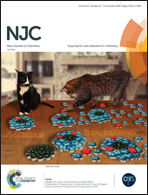High-affinity binding with specific peptides endows EuW10 a good luminescence probe for HPV E6 detection†
Abstract
Human papillomavirus (HPV) E6, acting as a major oncoprotein of high-risk sub-type, is known as an ideal biomarker with diagnostic potential. Due to the bottleneck lacking effective, commercially available mono-clonal antibody (mAbs) for HPV16 E6, we report a new luminescence protocol for the in vitro E6 detection in the present study. By selecting an inorganic cluster, Na9[EuW10O36]·32H2O (EuW10) that contains nine negative charges as a fluorescence probe, a concentration as low as 0.28 μM for HPV16 E6 was detectable in buffer solution. For that, a small peptide rich in basic residues from E6 was used to construct the platform for the high-affinity interaction assay of protein to EuW10. Additionally, the binding mechanism between EuW10 with peptide and protein was revealed in detail by time-resolved fluorescence spectrometry and ITC, while the binding processes were monitored by TEM images. Therefore, the present study not only provides a practical support for the application of polyoxometalate (POM) clusters as biological probes to HPV E6 detection, but also is significant for the early diagnosis of HPV-induced cancers.



 Please wait while we load your content...
Please wait while we load your content...